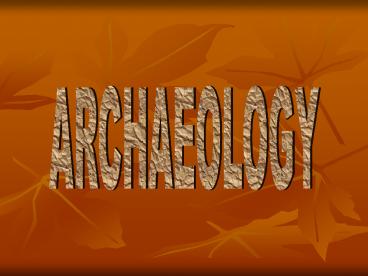ARCHAEOLOGY - PowerPoint PPT Presentation
ARCHAEOLOGY
Literary Resources and Records. Mounds. Dry Summer. Construction Sites. Arial photography. Many artifacts are lost to deterioration and decay. ... – PowerPoint PPT presentation
Title: ARCHAEOLOGY
1
ARCHAEOLOGY
2
WHAT IS ARCHAEOLOGY?
- Provides a primary source of information to
researchers and historians. The items studied
almost always come from the Earth and are called
artifacts.
3
TERMS YOU NEED TO KNOW
- Artifact- An object made by human beings
- Excavation- Digging material out of the ground
- Fossil- Ancient animal or plant remains preserved
in rocks - Inorganic Remains- Included here are stone tools
and pottery. By examining these artifacts an
archaeologist can determine its age and a great
deal about the people who used them. - Organic Remains- These include things that were
once living (human, animal or plant remains). The
best location for discovering organic artifacts
are dry and hot such as deserts or areas which
are cold and frozen.
4
HOW DO ITEMS BECOME BURIED?
- Deliberate burial- graves
- Volcanic Action
- People Abandon sites
- Collapsed buildings
- New layers added- streets.
5
HOW ARE SITES UNCOVERED?
- Literary Resources and Records
- Mounds
- Dry Summer
- Construction Sites
- Arial photography
- Many artifacts are lost to deterioration and
decay.
6
Why are these artifacts useful?
- Tools, weapons and utensils- reveal a great deal
about society and technology. - Paleo-Indians were the fist people of North
America.- Unique Stone tools (15) - DNA- can be used to track connections between
people and therefore theories of migration emerge.
7
METHODS OF DATING ARTIFACTS
- When artifacts are found in an archaeological
dig, the age of the item must be identified. - ABSOLUTE DATING- A precise date that is fixed in
actual years (radiocarbon dating) - Radiocarbon dating- used to date organic
materials- carbon - All living things absorb carbon.
- By testing the amount of carbon left an
approximate date can be determined. - CARBON DATING- comparing artifacts from a dated
site with similar artifacts.
PowerShow.com is a leading presentation sharing website. It has millions of presentations already uploaded and available with 1,000s more being uploaded by its users every day. Whatever your area of interest, here you’ll be able to find and view presentations you’ll love and possibly download. And, best of all, it is completely free and easy to use.
You might even have a presentation you’d like to share with others. If so, just upload it to PowerShow.com. We’ll convert it to an HTML5 slideshow that includes all the media types you’ve already added: audio, video, music, pictures, animations and transition effects. Then you can share it with your target audience as well as PowerShow.com’s millions of monthly visitors. And, again, it’s all free.
About the Developers
PowerShow.com is brought to you by CrystalGraphics, the award-winning developer and market-leading publisher of rich-media enhancement products for presentations. Our product offerings include millions of PowerPoint templates, diagrams, animated 3D characters and more.



















![[DOWNLOAD]⚡️PDF✔️ What is Media Archaeology? PowerPoint PPT Presentation](https://s3.amazonaws.com/images.powershow.com/10051378.th0.jpg?_=20240609108)

![[DOWNLOAD]PDF What is Media Archaeology? PowerPoint PPT Presentation](https://s3.amazonaws.com/images.powershow.com/10052078.th0.jpg?_=202406101212)




![[DOWNLOAD]⚡️PDF✔️ The Archaeology of Political Structure: Settlement Analysis in a Classic Maya PowerPoint PPT Presentation](https://s3.amazonaws.com/images.powershow.com/10056655.th0.jpg?_=202406160711)




